Case Study: Hypertension and Depression in Elderly Patients - Report
VerifiedAdded on 2022/12/26
|12
|2703
|1
Report
AI Summary
This report analyzes a case study involving a 72-year-old female patient, Mrs. Berry, who experienced a fractured neck of femur and presented with hypertension and depression. The report identifies abnormal cues, discusses the pathophysiology of both conditions, and outlines nursing goals and interventions. It includes a detailed examination of two prescribed medications, Doxepin and Atorvastatin, covering their mechanisms of action, side effects, dosages, and contraindications. The report emphasizes the importance of nursing interventions such as monitoring vital signs, providing patient education, and facilitating social interaction to manage the patient's physical and emotional well-being. The analysis incorporates relevant literature to support the rationale behind the interventions and discusses evaluation methods to assess their effectiveness.
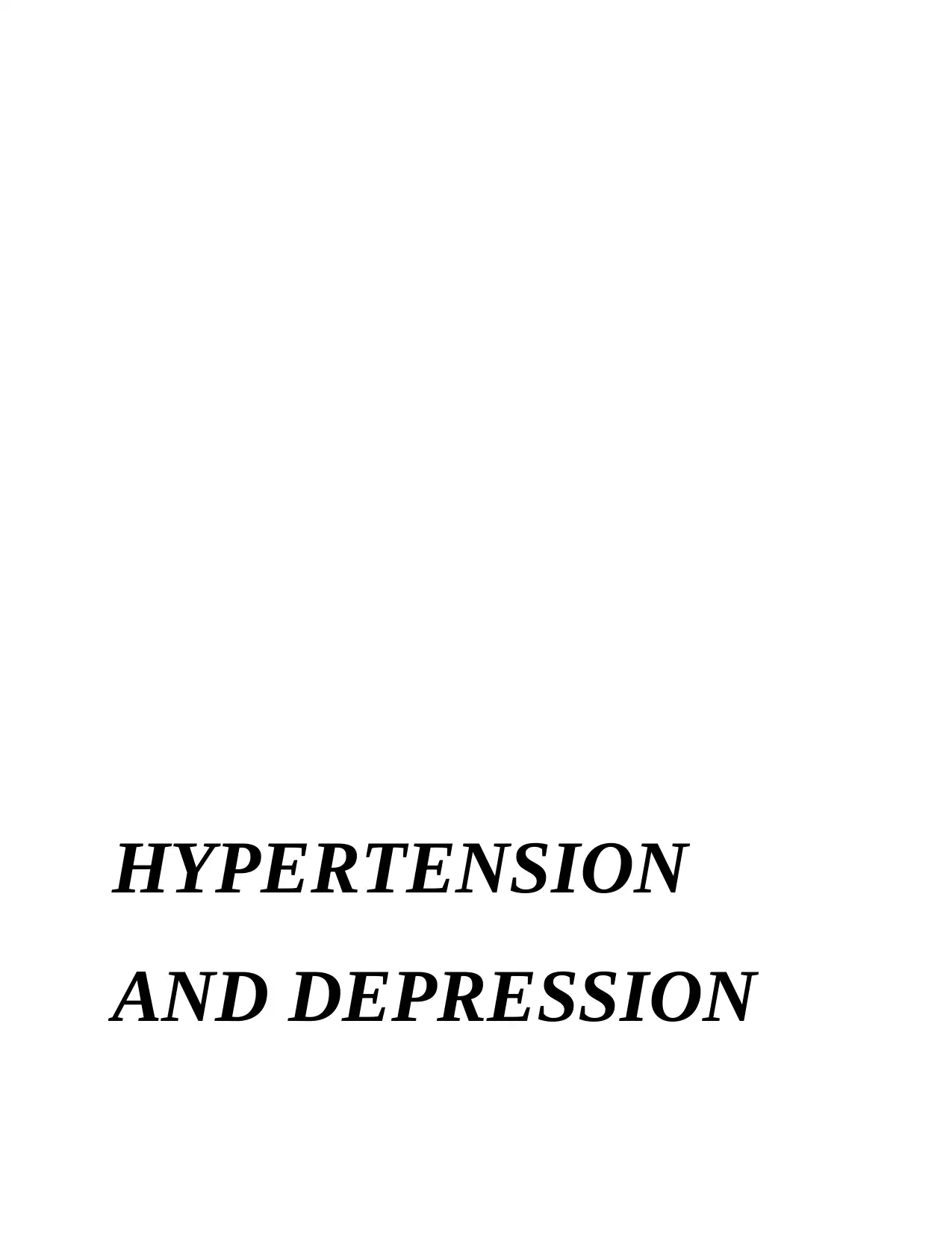
HYPERTENSION
AND DEPRESSION
AND DEPRESSION
Paraphrase This Document
Need a fresh take? Get an instant paraphrase of this document with our AI Paraphraser

Contents
INTRODUCTION...........................................................................................................................5
MAIN BODY...................................................................................................................................5
Section1Using the CRC and the information presented about Geraldine, identify the abnormal
cues and discuss why these are considered abnormal............................................................5
Section2 using relevant literature discuss the pathophysiology related to depression and
hypertension...........................................................................................................................7
Section3 using the template provided below complete the sections......................................8
Identify the nursing goal for each issue .................................................................................8
List atleast two nursing interventions for each issue.............................................................8
Section 4Using relevant literature, provide a rationale for the listed intervention and discuss
how the interventions will be evaluated.................................................................................9
Section5 identify two medication that were prescribed for the patient pre- operative condition.
Such as Doxepin 25 mg daily and Atorvastatin 40 mg dail, provide the mechanism of action,
side effects and correct dosage and contraindications for each medication.........................10
CONCLUSION..............................................................................................................................12
REFERENCES..............................................................................................................................13
INTRODUCTION...........................................................................................................................5
MAIN BODY...................................................................................................................................5
Section1Using the CRC and the information presented about Geraldine, identify the abnormal
cues and discuss why these are considered abnormal............................................................5
Section2 using relevant literature discuss the pathophysiology related to depression and
hypertension...........................................................................................................................7
Section3 using the template provided below complete the sections......................................8
Identify the nursing goal for each issue .................................................................................8
List atleast two nursing interventions for each issue.............................................................8
Section 4Using relevant literature, provide a rationale for the listed intervention and discuss
how the interventions will be evaluated.................................................................................9
Section5 identify two medication that were prescribed for the patient pre- operative condition.
Such as Doxepin 25 mg daily and Atorvastatin 40 mg dail, provide the mechanism of action,
side effects and correct dosage and contraindications for each medication.........................10
CONCLUSION..............................................................................................................................12
REFERENCES..............................................................................................................................13
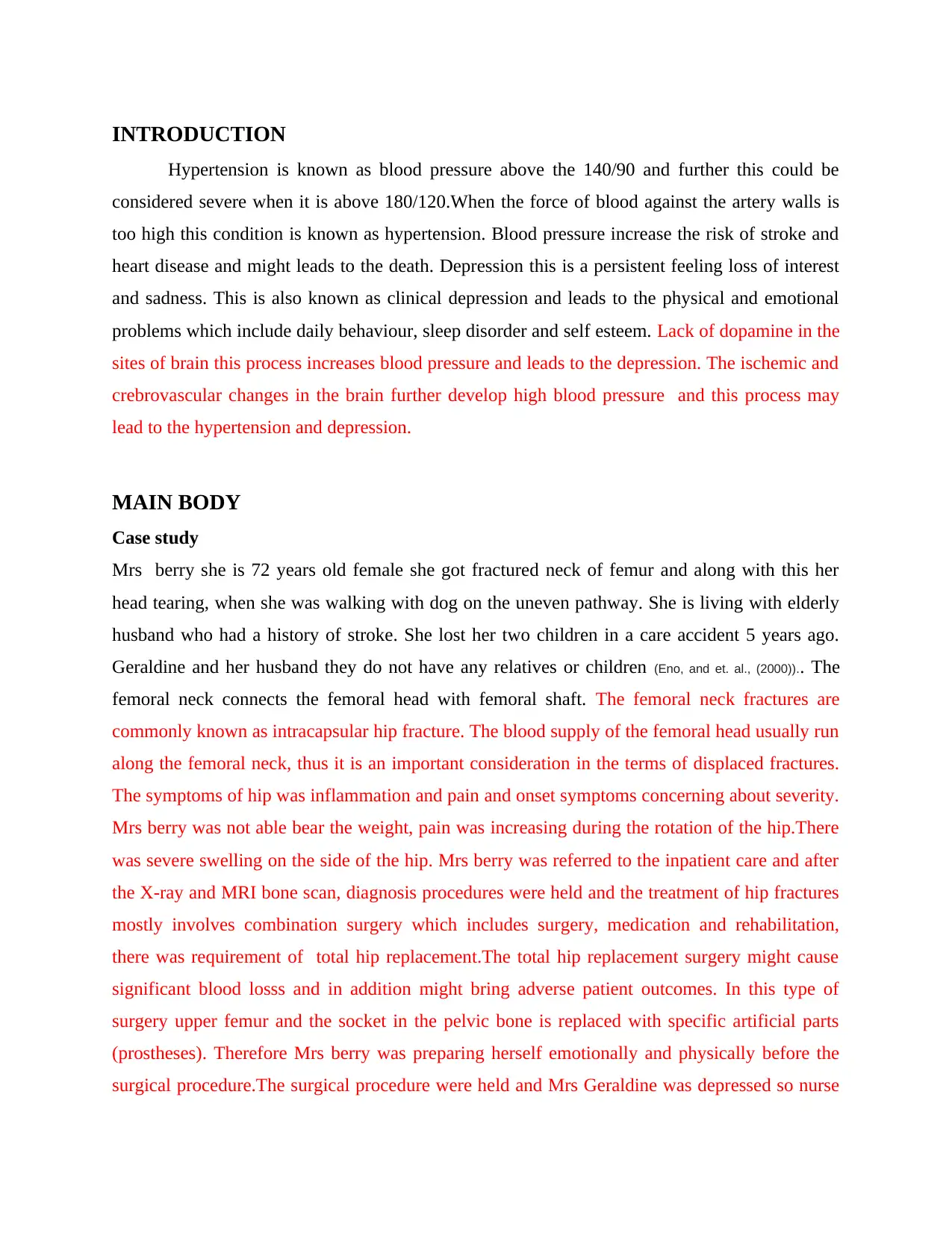
INTRODUCTION
Hypertension is known as blood pressure above the 140/90 and further this could be
considered severe when it is above 180/120.When the force of blood against the artery walls is
too high this condition is known as hypertension. Blood pressure increase the risk of stroke and
heart disease and might leads to the death. Depression this is a persistent feeling loss of interest
and sadness. This is also known as clinical depression and leads to the physical and emotional
problems which include daily behaviour, sleep disorder and self esteem. Lack of dopamine in the
sites of brain this process increases blood pressure and leads to the depression. The ischemic and
crebrovascular changes in the brain further develop high blood pressure and this process may
lead to the hypertension and depression.
MAIN BODY
Case study
Mrs berry she is 72 years old female she got fractured neck of femur and along with this her
head tearing, when she was walking with dog on the uneven pathway. She is living with elderly
husband who had a history of stroke. She lost her two children in a care accident 5 years ago.
Geraldine and her husband they do not have any relatives or children (Eno, and et. al., (2000)).. The
femoral neck connects the femoral head with femoral shaft. The femoral neck fractures are
commonly known as intracapsular hip fracture. The blood supply of the femoral head usually run
along the femoral neck, thus it is an important consideration in the terms of displaced fractures.
The symptoms of hip was inflammation and pain and onset symptoms concerning about severity.
Mrs berry was not able bear the weight, pain was increasing during the rotation of the hip.There
was severe swelling on the side of the hip. Mrs berry was referred to the inpatient care and after
the X-ray and MRI bone scan, diagnosis procedures were held and the treatment of hip fractures
mostly involves combination surgery which includes surgery, medication and rehabilitation,
there was requirement of total hip replacement.The total hip replacement surgery might cause
significant blood losss and in addition might bring adverse patient outcomes. In this type of
surgery upper femur and the socket in the pelvic bone is replaced with specific artificial parts
(prostheses). Therefore Mrs berry was preparing herself emotionally and physically before the
surgical procedure.The surgical procedure were held and Mrs Geraldine was depressed so nurse
Hypertension is known as blood pressure above the 140/90 and further this could be
considered severe when it is above 180/120.When the force of blood against the artery walls is
too high this condition is known as hypertension. Blood pressure increase the risk of stroke and
heart disease and might leads to the death. Depression this is a persistent feeling loss of interest
and sadness. This is also known as clinical depression and leads to the physical and emotional
problems which include daily behaviour, sleep disorder and self esteem. Lack of dopamine in the
sites of brain this process increases blood pressure and leads to the depression. The ischemic and
crebrovascular changes in the brain further develop high blood pressure and this process may
lead to the hypertension and depression.
MAIN BODY
Case study
Mrs berry she is 72 years old female she got fractured neck of femur and along with this her
head tearing, when she was walking with dog on the uneven pathway. She is living with elderly
husband who had a history of stroke. She lost her two children in a care accident 5 years ago.
Geraldine and her husband they do not have any relatives or children (Eno, and et. al., (2000)).. The
femoral neck connects the femoral head with femoral shaft. The femoral neck fractures are
commonly known as intracapsular hip fracture. The blood supply of the femoral head usually run
along the femoral neck, thus it is an important consideration in the terms of displaced fractures.
The symptoms of hip was inflammation and pain and onset symptoms concerning about severity.
Mrs berry was not able bear the weight, pain was increasing during the rotation of the hip.There
was severe swelling on the side of the hip. Mrs berry was referred to the inpatient care and after
the X-ray and MRI bone scan, diagnosis procedures were held and the treatment of hip fractures
mostly involves combination surgery which includes surgery, medication and rehabilitation,
there was requirement of total hip replacement.The total hip replacement surgery might cause
significant blood losss and in addition might bring adverse patient outcomes. In this type of
surgery upper femur and the socket in the pelvic bone is replaced with specific artificial parts
(prostheses). Therefore Mrs berry was preparing herself emotionally and physically before the
surgical procedure.The surgical procedure were held and Mrs Geraldine was depressed so nurse
⊘ This is a preview!⊘
Do you want full access?
Subscribe today to unlock all pages.

Trusted by 1+ million students worldwide
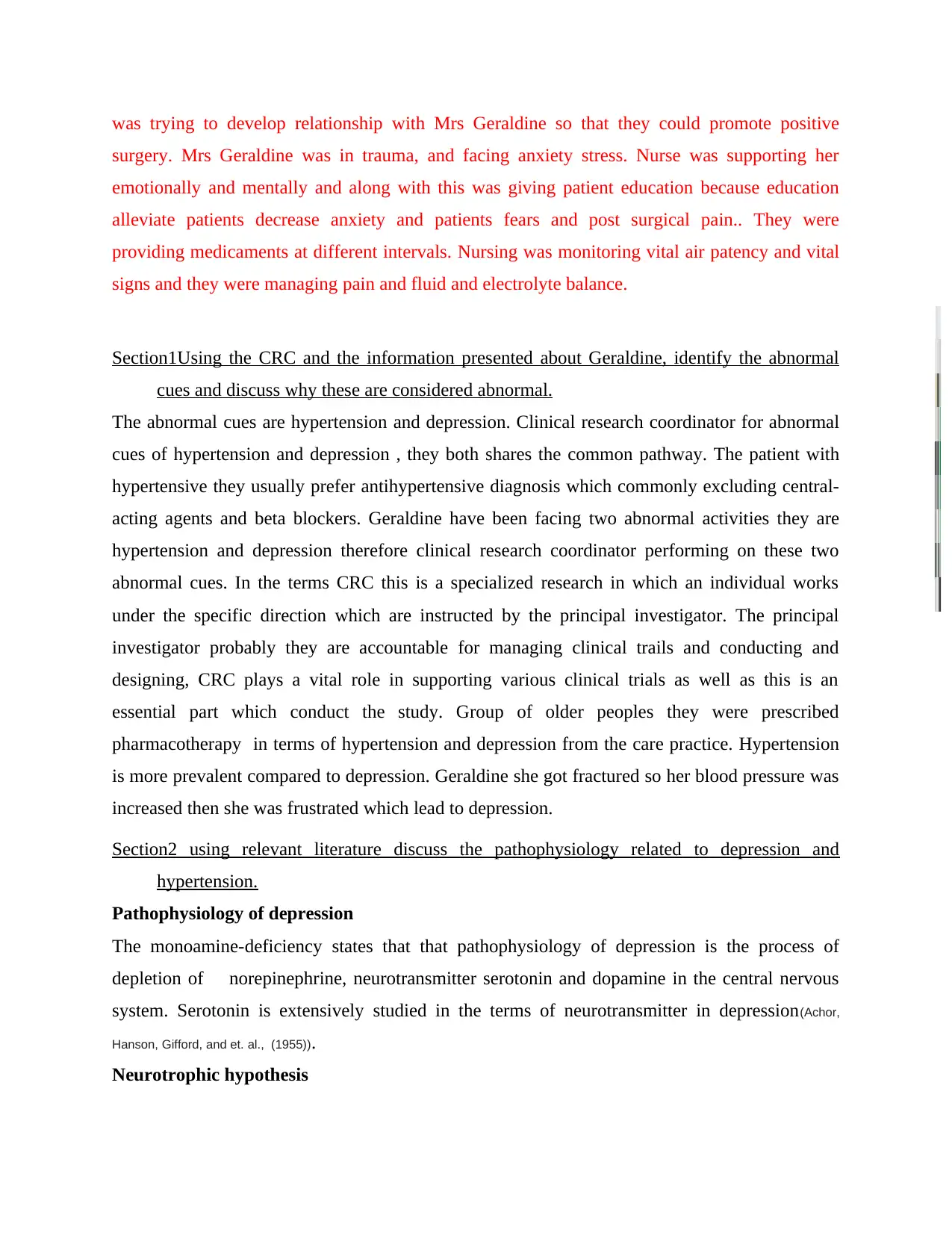
was trying to develop relationship with Mrs Geraldine so that they could promote positive
surgery. Mrs Geraldine was in trauma, and facing anxiety stress. Nurse was supporting her
emotionally and mentally and along with this was giving patient education because education
alleviate patients decrease anxiety and patients fears and post surgical pain.. They were
providing medicaments at different intervals. Nursing was monitoring vital air patency and vital
signs and they were managing pain and fluid and electrolyte balance.
Section1Using the CRC and the information presented about Geraldine, identify the abnormal
cues and discuss why these are considered abnormal.
The abnormal cues are hypertension and depression. Clinical research coordinator for abnormal
cues of hypertension and depression , they both shares the common pathway. The patient with
hypertensive they usually prefer antihypertensive diagnosis which commonly excluding central-
acting agents and beta blockers. Geraldine have been facing two abnormal activities they are
hypertension and depression therefore clinical research coordinator performing on these two
abnormal cues. In the terms CRC this is a specialized research in which an individual works
under the specific direction which are instructed by the principal investigator. The principal
investigator probably they are accountable for managing clinical trails and conducting and
designing, CRC plays a vital role in supporting various clinical trials as well as this is an
essential part which conduct the study. Group of older peoples they were prescribed
pharmacotherapy in terms of hypertension and depression from the care practice. Hypertension
is more prevalent compared to depression. Geraldine she got fractured so her blood pressure was
increased then she was frustrated which lead to depression.
Section2 using relevant literature discuss the pathophysiology related to depression and
hypertension.
Pathophysiology of depression
The monoamine-deficiency states that that pathophysiology of depression is the process of
depletion of norepinephrine, neurotransmitter serotonin and dopamine in the central nervous
system. Serotonin is extensively studied in the terms of neurotransmitter in depression(Achor,
Hanson, Gifford, and et. al., (1955)).
Neurotrophic hypothesis
surgery. Mrs Geraldine was in trauma, and facing anxiety stress. Nurse was supporting her
emotionally and mentally and along with this was giving patient education because education
alleviate patients decrease anxiety and patients fears and post surgical pain.. They were
providing medicaments at different intervals. Nursing was monitoring vital air patency and vital
signs and they were managing pain and fluid and electrolyte balance.
Section1Using the CRC and the information presented about Geraldine, identify the abnormal
cues and discuss why these are considered abnormal.
The abnormal cues are hypertension and depression. Clinical research coordinator for abnormal
cues of hypertension and depression , they both shares the common pathway. The patient with
hypertensive they usually prefer antihypertensive diagnosis which commonly excluding central-
acting agents and beta blockers. Geraldine have been facing two abnormal activities they are
hypertension and depression therefore clinical research coordinator performing on these two
abnormal cues. In the terms CRC this is a specialized research in which an individual works
under the specific direction which are instructed by the principal investigator. The principal
investigator probably they are accountable for managing clinical trails and conducting and
designing, CRC plays a vital role in supporting various clinical trials as well as this is an
essential part which conduct the study. Group of older peoples they were prescribed
pharmacotherapy in terms of hypertension and depression from the care practice. Hypertension
is more prevalent compared to depression. Geraldine she got fractured so her blood pressure was
increased then she was frustrated which lead to depression.
Section2 using relevant literature discuss the pathophysiology related to depression and
hypertension.
Pathophysiology of depression
The monoamine-deficiency states that that pathophysiology of depression is the process of
depletion of norepinephrine, neurotransmitter serotonin and dopamine in the central nervous
system. Serotonin is extensively studied in the terms of neurotransmitter in depression(Achor,
Hanson, Gifford, and et. al., (1955)).
Neurotrophic hypothesis
Paraphrase This Document
Need a fresh take? Get an instant paraphrase of this document with our AI Paraphraser

Brain usually derived the growth factor which further promotes the development and growth of
the immature neurons which mainly include the mono-aminergic neurons increases the function
and survival of adult neurons. Furthermore the low brain derived growth might be responsible
for the loss mono -aminergic neurons and there also may be losss of functions and other brain
areas.
Receptor sensitivity hypothesis
Depression is resulting into pathophysiological alteration in the receptor sites.
The serotonin –only hypothesis
They give more emphasizes to the serotonin in terms of depression but later on reduce the
noradrenaline. But the theory of serotonin does not explain the reason of delaying clinical relief
as well as they also do not explain the role of NA in terms of depression.
The permissive hypothesis
This process probably controls the behaviour and emotions which further maintains the balance
between serotonin and noradrenaline. If the level of noradrenaline and serotonin falls , then there
might be possibility that patient becomes depressed. But if the levels serotonin falls and along
with this levels of noradrenaline becomes abnormal too, then patient may becomes manic.
Clinical manifestation
Depression
Loss of appetite , weight loss in both case of insomnia and hypersomia.
In some cases there might be possibility that symptoms related to delusion and
hallucination might be present.
The cognitive symptoms may include reduction in the concentration as well as slowed
thinking, this resulted into poor memory.
Thinking this is quite pessimistic but in some case it could be suicidal
Pathophysiology of hypertension
Hypertension this is also known as blood pressure and it is a long-term condition in which bllod
flows against the walls of the arteries. The systolic blood pressure is considered as 140mmhg and
the diastolic blood pressure is considered as more than or equal as 90mmhg.
Pathophysiology
Sympathetic nervous system activities
the immature neurons which mainly include the mono-aminergic neurons increases the function
and survival of adult neurons. Furthermore the low brain derived growth might be responsible
for the loss mono -aminergic neurons and there also may be losss of functions and other brain
areas.
Receptor sensitivity hypothesis
Depression is resulting into pathophysiological alteration in the receptor sites.
The serotonin –only hypothesis
They give more emphasizes to the serotonin in terms of depression but later on reduce the
noradrenaline. But the theory of serotonin does not explain the reason of delaying clinical relief
as well as they also do not explain the role of NA in terms of depression.
The permissive hypothesis
This process probably controls the behaviour and emotions which further maintains the balance
between serotonin and noradrenaline. If the level of noradrenaline and serotonin falls , then there
might be possibility that patient becomes depressed. But if the levels serotonin falls and along
with this levels of noradrenaline becomes abnormal too, then patient may becomes manic.
Clinical manifestation
Depression
Loss of appetite , weight loss in both case of insomnia and hypersomia.
In some cases there might be possibility that symptoms related to delusion and
hallucination might be present.
The cognitive symptoms may include reduction in the concentration as well as slowed
thinking, this resulted into poor memory.
Thinking this is quite pessimistic but in some case it could be suicidal
Pathophysiology of hypertension
Hypertension this is also known as blood pressure and it is a long-term condition in which bllod
flows against the walls of the arteries. The systolic blood pressure is considered as 140mmhg and
the diastolic blood pressure is considered as more than or equal as 90mmhg.
Pathophysiology
Sympathetic nervous system activities

When the blood pressure is low then the activation of sympathetic nervous system activities
would occur. The inceasement in the sympathetic nervous system activities further will increase
the cardiac contraction and heart rate. Increased in cardiac contraction and heart rate will
produce vasoconstriction in the peripheral arterioles.
Pharmacological therapy
There are numerous drugs which are used for the treatment of hypertension and they are called
antihypertensive drugs.
Beta blocker – These type of medicaments reduces the workload of bllod vessels and heart and
this will cause the heart to beat with less force for example propanolol and atenolol.
Vasodilators – These drugs they directly act on the walls of arteries the muscles and this process
inhibit the arteries from narrowing and muscles from tightening for example sodium nitro
prusside, nitroglycerin.
Section3 using the template provided below complete the sections.
Identify the nursing goal for each issue .
List atleast two nursing interventions for each issue
Problem Goal Intervention
Hypertension Focus on controlling and
lowering of blood pressure
Examining or checking the
laboratory data, such as
complete blood count and
cardiac makers, electrolytes
and cardiac enzymes.
Decrease the risk of cardiac
output.
Providing the restful
surrounding decresing the
noise activity.
Prevention of complication Monitoring the medication
in order to control the blood
pressure.
would occur. The inceasement in the sympathetic nervous system activities further will increase
the cardiac contraction and heart rate. Increased in cardiac contraction and heart rate will
produce vasoconstriction in the peripheral arterioles.
Pharmacological therapy
There are numerous drugs which are used for the treatment of hypertension and they are called
antihypertensive drugs.
Beta blocker – These type of medicaments reduces the workload of bllod vessels and heart and
this will cause the heart to beat with less force for example propanolol and atenolol.
Vasodilators – These drugs they directly act on the walls of arteries the muscles and this process
inhibit the arteries from narrowing and muscles from tightening for example sodium nitro
prusside, nitroglycerin.
Section3 using the template provided below complete the sections.
Identify the nursing goal for each issue .
List atleast two nursing interventions for each issue
Problem Goal Intervention
Hypertension Focus on controlling and
lowering of blood pressure
Examining or checking the
laboratory data, such as
complete blood count and
cardiac makers, electrolytes
and cardiac enzymes.
Decrease the risk of cardiac
output.
Providing the restful
surrounding decresing the
noise activity.
Prevention of complication Monitoring the medication
in order to control the blood
pressure.
⊘ This is a preview!⊘
Do you want full access?
Subscribe today to unlock all pages.

Trusted by 1+ million students worldwide
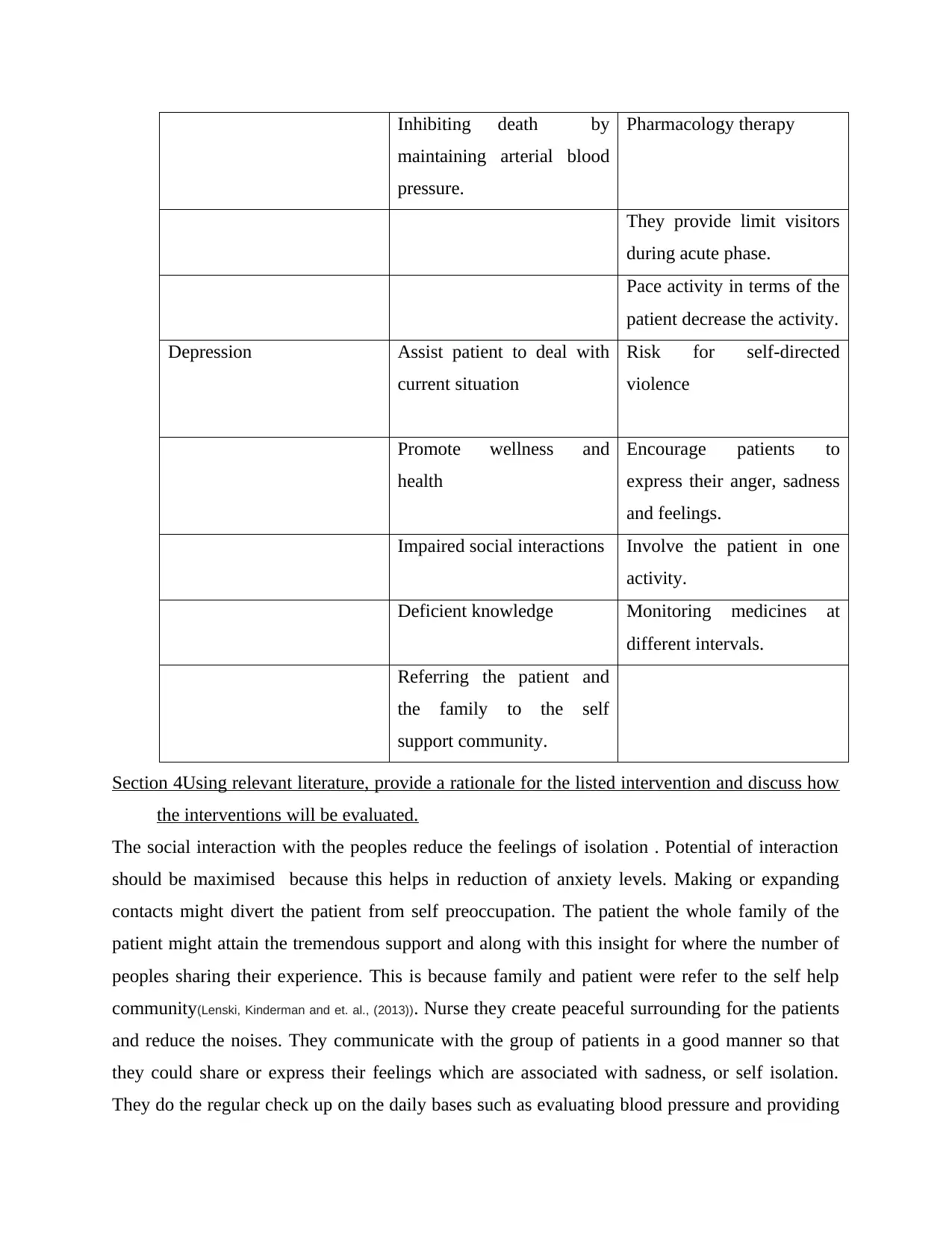
Inhibiting death by
maintaining arterial blood
pressure.
Pharmacology therapy
They provide limit visitors
during acute phase.
Pace activity in terms of the
patient decrease the activity.
Depression Assist patient to deal with
current situation
Risk for self-directed
violence
Promote wellness and
health
Encourage patients to
express their anger, sadness
and feelings.
Impaired social interactions Involve the patient in one
activity.
Deficient knowledge Monitoring medicines at
different intervals.
Referring the patient and
the family to the self
support community.
Section 4Using relevant literature, provide a rationale for the listed intervention and discuss how
the interventions will be evaluated.
The social interaction with the peoples reduce the feelings of isolation . Potential of interaction
should be maximised because this helps in reduction of anxiety levels. Making or expanding
contacts might divert the patient from self preoccupation. The patient the whole family of the
patient might attain the tremendous support and along with this insight for where the number of
peoples sharing their experience. This is because family and patient were refer to the self help
community(Lenski, Kinderman and et. al., (2013)). Nurse they create peaceful surrounding for the patients
and reduce the noises. They communicate with the group of patients in a good manner so that
they could share or express their feelings which are associated with sadness, or self isolation.
They do the regular check up on the daily bases such as evaluating blood pressure and providing
maintaining arterial blood
pressure.
Pharmacology therapy
They provide limit visitors
during acute phase.
Pace activity in terms of the
patient decrease the activity.
Depression Assist patient to deal with
current situation
Risk for self-directed
violence
Promote wellness and
health
Encourage patients to
express their anger, sadness
and feelings.
Impaired social interactions Involve the patient in one
activity.
Deficient knowledge Monitoring medicines at
different intervals.
Referring the patient and
the family to the self
support community.
Section 4Using relevant literature, provide a rationale for the listed intervention and discuss how
the interventions will be evaluated.
The social interaction with the peoples reduce the feelings of isolation . Potential of interaction
should be maximised because this helps in reduction of anxiety levels. Making or expanding
contacts might divert the patient from self preoccupation. The patient the whole family of the
patient might attain the tremendous support and along with this insight for where the number of
peoples sharing their experience. This is because family and patient were refer to the self help
community(Lenski, Kinderman and et. al., (2013)). Nurse they create peaceful surrounding for the patients
and reduce the noises. They communicate with the group of patients in a good manner so that
they could share or express their feelings which are associated with sadness, or self isolation.
They do the regular check up on the daily bases such as evaluating blood pressure and providing
Paraphrase This Document
Need a fresh take? Get an instant paraphrase of this document with our AI Paraphraser
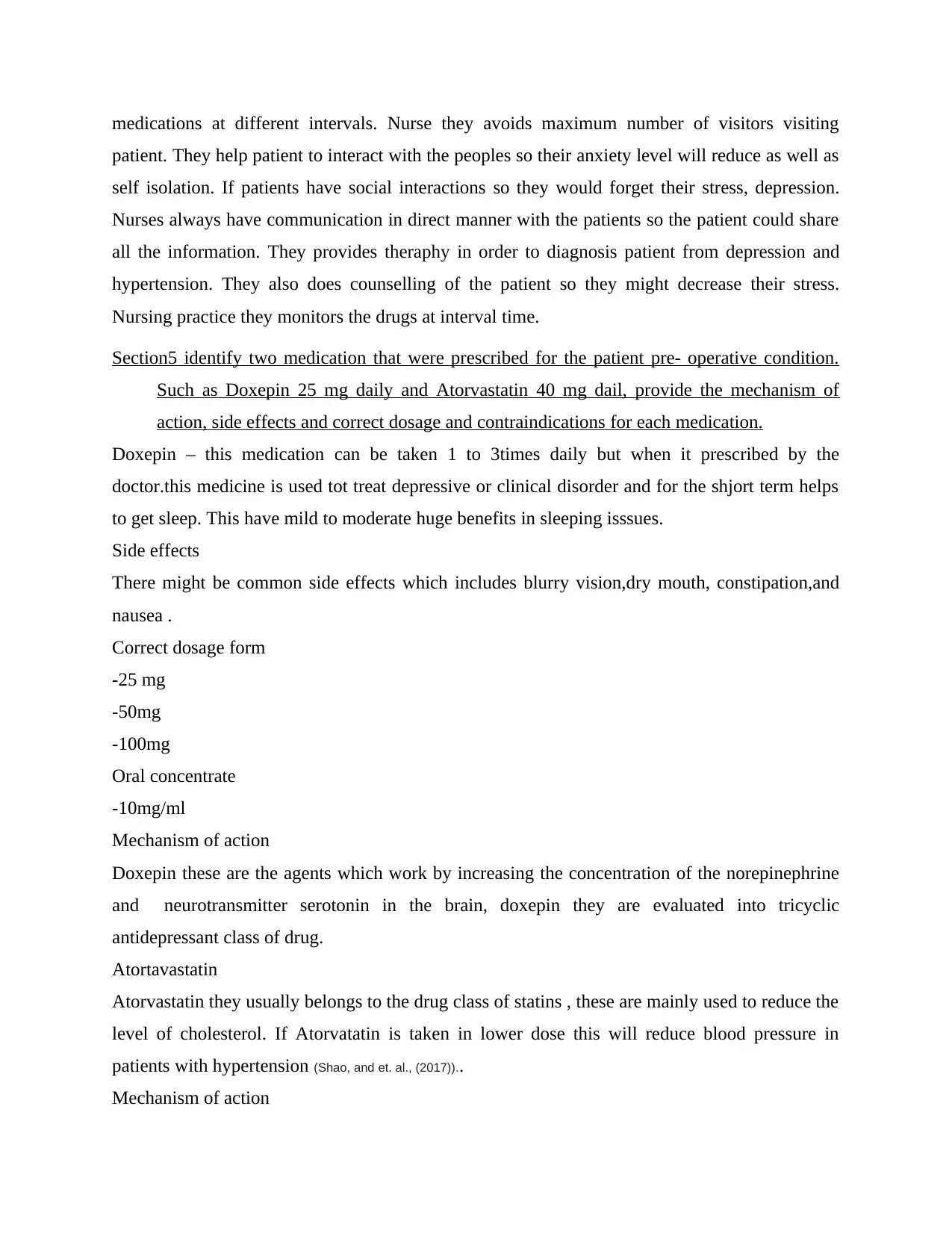
medications at different intervals. Nurse they avoids maximum number of visitors visiting
patient. They help patient to interact with the peoples so their anxiety level will reduce as well as
self isolation. If patients have social interactions so they would forget their stress, depression.
Nurses always have communication in direct manner with the patients so the patient could share
all the information. They provides theraphy in order to diagnosis patient from depression and
hypertension. They also does counselling of the patient so they might decrease their stress.
Nursing practice they monitors the drugs at interval time.
Section5 identify two medication that were prescribed for the patient pre- operative condition.
Such as Doxepin 25 mg daily and Atorvastatin 40 mg dail, provide the mechanism of
action, side effects and correct dosage and contraindications for each medication.
Doxepin – this medication can be taken 1 to 3times daily but when it prescribed by the
doctor.this medicine is used tot treat depressive or clinical disorder and for the shjort term helps
to get sleep. This have mild to moderate huge benefits in sleeping isssues.
Side effects
There might be common side effects which includes blurry vision,dry mouth, constipation,and
nausea .
Correct dosage form
-25 mg
-50mg
-100mg
Oral concentrate
-10mg/ml
Mechanism of action
Doxepin these are the agents which work by increasing the concentration of the norepinephrine
and neurotransmitter serotonin in the brain, doxepin they are evaluated into tricyclic
antidepressant class of drug.
Atortavastatin
Atorvastatin they usually belongs to the drug class of statins , these are mainly used to reduce the
level of cholesterol. If Atorvatatin is taken in lower dose this will reduce blood pressure in
patients with hypertension (Shao, and et. al., (2017))..
Mechanism of action
patient. They help patient to interact with the peoples so their anxiety level will reduce as well as
self isolation. If patients have social interactions so they would forget their stress, depression.
Nurses always have communication in direct manner with the patients so the patient could share
all the information. They provides theraphy in order to diagnosis patient from depression and
hypertension. They also does counselling of the patient so they might decrease their stress.
Nursing practice they monitors the drugs at interval time.
Section5 identify two medication that were prescribed for the patient pre- operative condition.
Such as Doxepin 25 mg daily and Atorvastatin 40 mg dail, provide the mechanism of
action, side effects and correct dosage and contraindications for each medication.
Doxepin – this medication can be taken 1 to 3times daily but when it prescribed by the
doctor.this medicine is used tot treat depressive or clinical disorder and for the shjort term helps
to get sleep. This have mild to moderate huge benefits in sleeping isssues.
Side effects
There might be common side effects which includes blurry vision,dry mouth, constipation,and
nausea .
Correct dosage form
-25 mg
-50mg
-100mg
Oral concentrate
-10mg/ml
Mechanism of action
Doxepin these are the agents which work by increasing the concentration of the norepinephrine
and neurotransmitter serotonin in the brain, doxepin they are evaluated into tricyclic
antidepressant class of drug.
Atortavastatin
Atorvastatin they usually belongs to the drug class of statins , these are mainly used to reduce the
level of cholesterol. If Atorvatatin is taken in lower dose this will reduce blood pressure in
patients with hypertension (Shao, and et. al., (2017))..
Mechanism of action
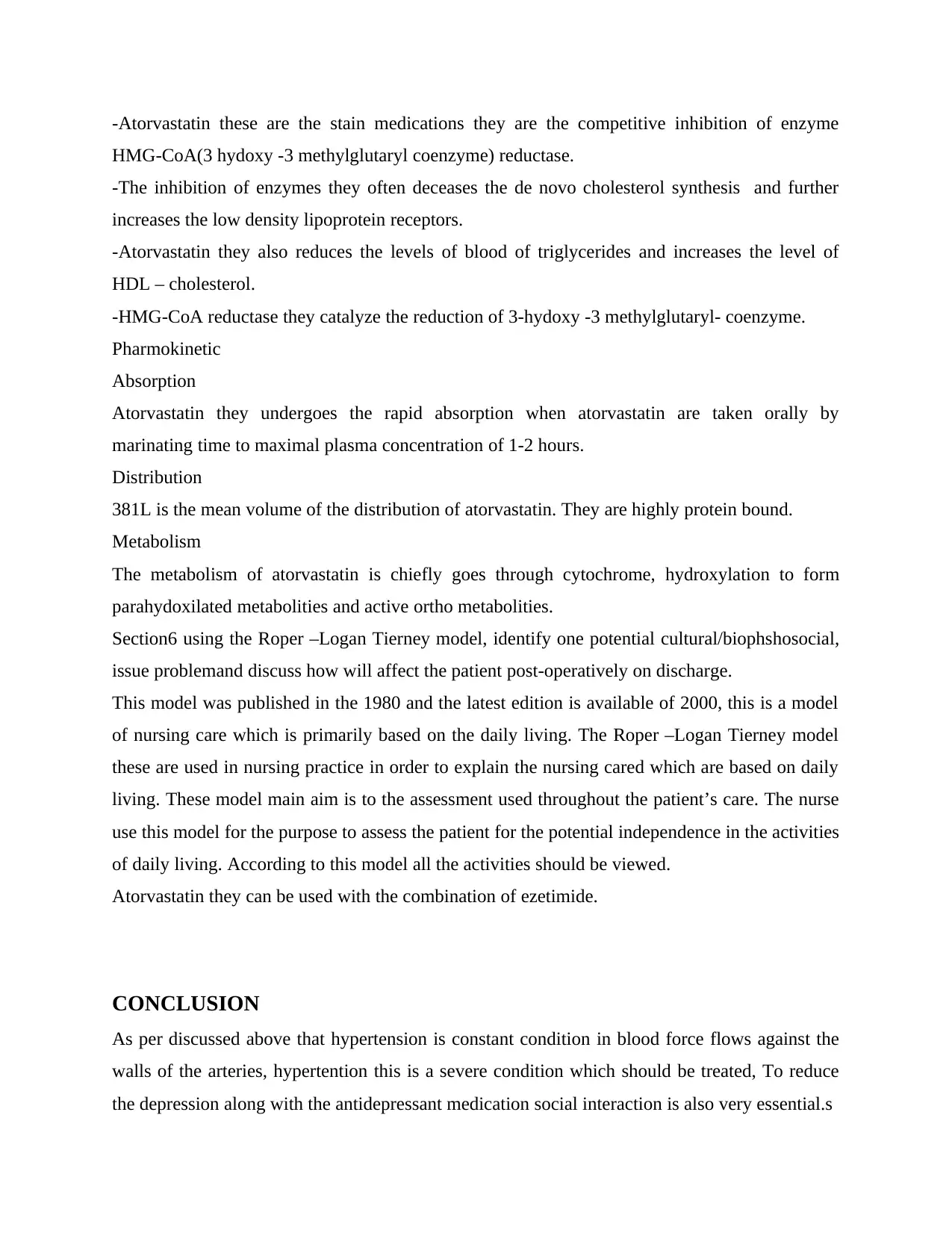
-Atorvastatin these are the stain medications they are the competitive inhibition of enzyme
HMG-CoA(3 hydoxy -3 methylglutaryl coenzyme) reductase.
-The inhibition of enzymes they often deceases the de novo cholesterol synthesis and further
increases the low density lipoprotein receptors.
-Atorvastatin they also reduces the levels of blood of triglycerides and increases the level of
HDL – cholesterol.
-HMG-CoA reductase they catalyze the reduction of 3-hydoxy -3 methylglutaryl- coenzyme.
Pharmokinetic
Absorption
Atorvastatin they undergoes the rapid absorption when atorvastatin are taken orally by
marinating time to maximal plasma concentration of 1-2 hours.
Distribution
381L is the mean volume of the distribution of atorvastatin. They are highly protein bound.
Metabolism
The metabolism of atorvastatin is chiefly goes through cytochrome, hydroxylation to form
parahydoxilated metabolities and active ortho metabolities.
Section6 using the Roper –Logan Tierney model, identify one potential cultural/biophshosocial,
issue problemand discuss how will affect the patient post-operatively on discharge.
This model was published in the 1980 and the latest edition is available of 2000, this is a model
of nursing care which is primarily based on the daily living. The Roper –Logan Tierney model
these are used in nursing practice in order to explain the nursing cared which are based on daily
living. These model main aim is to the assessment used throughout the patient’s care. The nurse
use this model for the purpose to assess the patient for the potential independence in the activities
of daily living. According to this model all the activities should be viewed.
Atorvastatin they can be used with the combination of ezetimide.
CONCLUSION
As per discussed above that hypertension is constant condition in blood force flows against the
walls of the arteries, hypertention this is a severe condition which should be treated, To reduce
the depression along with the antidepressant medication social interaction is also very essential.s
HMG-CoA(3 hydoxy -3 methylglutaryl coenzyme) reductase.
-The inhibition of enzymes they often deceases the de novo cholesterol synthesis and further
increases the low density lipoprotein receptors.
-Atorvastatin they also reduces the levels of blood of triglycerides and increases the level of
HDL – cholesterol.
-HMG-CoA reductase they catalyze the reduction of 3-hydoxy -3 methylglutaryl- coenzyme.
Pharmokinetic
Absorption
Atorvastatin they undergoes the rapid absorption when atorvastatin are taken orally by
marinating time to maximal plasma concentration of 1-2 hours.
Distribution
381L is the mean volume of the distribution of atorvastatin. They are highly protein bound.
Metabolism
The metabolism of atorvastatin is chiefly goes through cytochrome, hydroxylation to form
parahydoxilated metabolities and active ortho metabolities.
Section6 using the Roper –Logan Tierney model, identify one potential cultural/biophshosocial,
issue problemand discuss how will affect the patient post-operatively on discharge.
This model was published in the 1980 and the latest edition is available of 2000, this is a model
of nursing care which is primarily based on the daily living. The Roper –Logan Tierney model
these are used in nursing practice in order to explain the nursing cared which are based on daily
living. These model main aim is to the assessment used throughout the patient’s care. The nurse
use this model for the purpose to assess the patient for the potential independence in the activities
of daily living. According to this model all the activities should be viewed.
Atorvastatin they can be used with the combination of ezetimide.
CONCLUSION
As per discussed above that hypertension is constant condition in blood force flows against the
walls of the arteries, hypertention this is a severe condition which should be treated, To reduce
the depression along with the antidepressant medication social interaction is also very essential.s
⊘ This is a preview!⊘
Do you want full access?
Subscribe today to unlock all pages.

Trusted by 1+ million students worldwide

REFERENCES
(Shao, and et. al., (2017)). Evaluating excessive burden of depression on health status and health care utilization among patients
with hypertension in a nationally representative sample from the Medial Expenditure Panel Survey (MEPS 2012). The Journal of
nervous and mental disease, 205(5), 397-404.
(Eno, and et. al., (2000)). Blood pressure depression by the fruit juice of Carica papaya (L.) in renal and DOCA ‐induced
hypertension in the rat. Phytotherapy Research: An International Journal Devoted to Pharmacological and Toxicological Evaluation
of Natural Product Derivatives, 14(4), 235-239.
(Lenski, Kinderman and et. al., (2013)). Anxiety, depression, quality of life and stress in patients with resistant hypertension before
and after catheter-based renal sympathetic denervation. EuroIntervention: journal of EuroPCR in collaboration with the Working
Group on Interventional Cardiology of the European Society of Cardiology, 9(6), 700-708.
(Achor, Hanson, Gifford, and et. al., (1955)) Hypertension treated with Rauwolfia serpentina (whole root) and with reserpine:
controlled study disclosing occasional severe depression. Journal of the American Medical Association, 159(9), 841-845.
(Cao, and et. al.,. (2020)). Prevalence, correlates and misperception of depression symptoms in the United States, NHANES 2015–
2018. Journal of affective disorders, 269, 51-57.
(Sadeghi, Keshteli, Afshar, Esmaillzadeh, and et. al., (2019)). Adherence to Mediterranean dietary pattern is inversely associated
with depression, anxiety and psychological distress. Nutritional neuroscience, 1-12.
(Shao, and et. al., (2017)). Evaluating excessive burden of depression on health status and health care utilization among patients
with hypertension in a nationally representative sample from the Medial Expenditure Panel Survey (MEPS 2012). The Journal of
nervous and mental disease, 205(5), 397-404.
(Eno, and et. al., (2000)). Blood pressure depression by the fruit juice of Carica papaya (L.) in renal and DOCA ‐induced
hypertension in the rat. Phytotherapy Research: An International Journal Devoted to Pharmacological and Toxicological Evaluation
of Natural Product Derivatives, 14(4), 235-239.
(Lenski, Kinderman and et. al., (2013)). Anxiety, depression, quality of life and stress in patients with resistant hypertension before
and after catheter-based renal sympathetic denervation. EuroIntervention: journal of EuroPCR in collaboration with the Working
Group on Interventional Cardiology of the European Society of Cardiology, 9(6), 700-708.
(Achor, Hanson, Gifford, and et. al., (1955)) Hypertension treated with Rauwolfia serpentina (whole root) and with reserpine:
controlled study disclosing occasional severe depression. Journal of the American Medical Association, 159(9), 841-845.
(Cao, and et. al.,. (2020)). Prevalence, correlates and misperception of depression symptoms in the United States, NHANES 2015–
2018. Journal of affective disorders, 269, 51-57.
(Sadeghi, Keshteli, Afshar, Esmaillzadeh, and et. al., (2019)). Adherence to Mediterranean dietary pattern is inversely associated
with depression, anxiety and psychological distress. Nutritional neuroscience, 1-12.
Paraphrase This Document
Need a fresh take? Get an instant paraphrase of this document with our AI Paraphraser


⊘ This is a preview!⊘
Do you want full access?
Subscribe today to unlock all pages.

Trusted by 1+ million students worldwide
1 out of 12
Related Documents
Your All-in-One AI-Powered Toolkit for Academic Success.
+13062052269
info@desklib.com
Available 24*7 on WhatsApp / Email
![[object Object]](/_next/static/media/star-bottom.7253800d.svg)
Unlock your academic potential
Copyright © 2020–2025 A2Z Services. All Rights Reserved. Developed and managed by ZUCOL.





